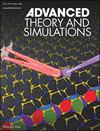塞来昔布和伐地昔布与一些常见极性溶剂分子水平非共价相互作用
IF 2.9
4区 工程技术
Q1 MULTIDISCIPLINARY SCIENCES
引用次数: 0
摘要
塞来昔布(CB)和伐地昔布(VB)是两种非甾体抗炎药,属于抗炎类药物。它们选择性地抑制环氧合酶-2酶,因此被用于治疗类风湿性关节炎和骨关节炎的几种症状。目前的研究重点是研究这些药物与一些随机选择的极性溶剂的相互作用。利用DFT理论的M06-2x/aug-cc-pVDZ水平,对12种配合物进行气相优化,并对其分子间相互作用进行了研究。在评估结合能后,进行前沿分子轨道分析和自然键轨道分析,了解配合物的电荷定位和轨道行为。利用分子中原子(AIM)、密度梯度还原(NCI-RDG)、Hirshfeld划分独立梯度模型(IGMH)、相互作用区域指示(IRI)、核价分岔(CVB)指数等理论工具识别分子间相互作用位点(氢键)及其强度。EDA分析给出了相互作用能量如何分散成各种能量分量的概念。结果表明,两种药物均能与DMSO有效相互作用。本文章由计算机程序翻译,如有差异,请以英文原文为准。

Molecular Level Non-Covalent Interactions Between Celecoxib and Valdecoxib and Some Common Polar Solvents
Celecoxib (CB) and Valdecoxib (VB) are two NSAIDs that belong to the category of anti-inflammatory drugs. They selectively inhibit the cyclooxygenase-2 enzyme and are hence used to treat several symptoms of rheumatoid and osteoarthritis. The current study focuses on investigating the interaction of these drugs with some randomly selected polar solvents explicitly. Using the M06-2x/aug-cc-pVDZ level of the theory of DFT, 12 complexes are optimized in the gas phase and their intermolecular interaction studies proceed. After the evaluation of binding energy, frontier molecular orbital analysis, and natural bond orbital analysis are carried out to get an idea of the charge localization and orbital behavior of complexes. Theoretical tools like an atom in molecule (AIM), reduced density gradient (NCI-RDG), independent gradient model based on Hirshfeld partition (IGMH), interaction region indicator (IRI), and core-valence bifurcation (CVB) index are used to identify the intermolecular interaction sites (hydrogen bond) and their strength. EDA analysis gave an idea of how the interaction energy is disseminated into various energy components. All the results obtained show that both drugs effectively interact with DMSO.
求助全文
通过发布文献求助,成功后即可免费获取论文全文。
去求助
来源期刊

Advanced Theory and Simulations
Multidisciplinary-Multidisciplinary
CiteScore
5.50
自引率
3.00%
发文量
221
期刊介绍:
Advanced Theory and Simulations is an interdisciplinary, international, English-language journal that publishes high-quality scientific results focusing on the development and application of theoretical methods, modeling and simulation approaches in all natural science and medicine areas, including:
materials, chemistry, condensed matter physics
engineering, energy
life science, biology, medicine
atmospheric/environmental science, climate science
planetary science, astronomy, cosmology
method development, numerical methods, statistics
 求助内容:
求助内容: 应助结果提醒方式:
应助结果提醒方式:


